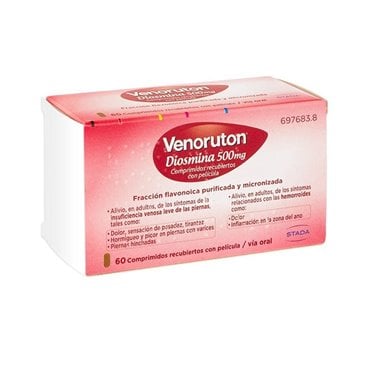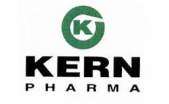Venoruton Diosmin 500mg 60 Tablets
Treatment of symptoms related to mild venous insufficiency in adults. Relief of symptoms related to hemorrhoids such as pain or inflammation in the anal area in adults.
Treatment of symptoms related to mild venous insufficiency in adults. Relief of symptoms related to hemorrhoids such as pain or inflammation in the anal area in adults.
Venoruton Diosmin (500 Mg 60 Coated Tablets)
Micronized purified flavonoid fraction 500 mg, containing:
Diosmin (90%): 450mg
Flavonoids expressed in Hesperidin (10%): 50 mg
ACTION AND MECHANISM
Venotonic and vasoprotective. Produces venoconstriction, increased vessel resistance, and decreased permeability.
In the animal, it exerts a double action on the venous return system:
- at the level of the veins and venules: increases parietal tone and exerts an antistatic action;
- at the microcirculation level: normalizes capillary permeability and strengthens capillary resistance.
In man, double-blind controlled studies have confirmed venotonic activity: venous tone increases: venous occlusion plethysmography with a mercury ring has revealed a decrease in venous emptying times.
It has also shown activity on microcirculation: in patients with signs of capillary fragility, capillary resistance measured by angiosterometry increases.
PHARMACOKINETICS
The pharmacokinetics of diosmin is linear.
Orally:
- Absorption: diosmin is rapidly transformed by the intestinal flora and is absorbed in its aglycone form (diosmetin). Bioavailability: 57.9% approx.
- Distribution: extensive (Vd: 62.1 L).
- Metabolism: Diosmetin is rapidly and extensively degraded to phlebotonic acids or their glycine-conjugated derivatives, which are eliminated in the urine. Predominant metabolite: hydroxyphenylpropionic acid (which is mostly eliminated conjugated). Metabolites in minor amounts: other phenolic acids corresponding to 1-hydroxy-4-methoxybenzoic acid, 3-methoxy-4-hydroxyphenylacetic acid and 3,4-dihydroxybenzoic acid.
- Elimination: relatively fast. In studies with radiolabeled diosmin, 34% of the dose was recovered in urine and feces after the first 24 hours, and approximately 86% was recovered in urine and feces after the first 48 hours.
INDICATIONS
- Short-term relief (2 to 3 months) of edema and symptoms related to chronic [VENOUS INSUFFICIENCY].
POSOLOGY
- Adults: Usual therapeutic dose: 2 tablets a day, divided into two doses, one tablet at noon and another at night, with meals.
- Children and adolescents < 18 years: not recommended.
- Elderly: does not require dose readjustment.
Duration of treatment : 2-3 months maximum.
RULES FOR CORRECT ADMINISTRATION
Take with meals (at noon and dinner).
CONTRAINDICATIONS
- Hypersensitivity to diosmin or other flavonoids.
ADVICE TO THE PATIENT
- It is recommended to take the tablets after lunch and dinner.
- This medication is intended for short-term treatment of venous insufficiency, for periods of less than 2-3 months.
PREGNANCY
There is no evidence of any harmful effect on the human species. Experimental studies have not shown any teratogenic effect.
Caution should be exercised when prescribing to pregnant women.
LACTATION
It is not known whether this drug is excreted in breast milk, however, in a study in animal models, minimal excretion in breast milk (1%) has been observed. In the absence of conclusive data on the transfer to breast milk, its use during lactation is not recommended.
CHILDREN
There is insufficient clinical experience in this age group. Use not recommended.
SENIORS
In one study, no significant differences in adverse effects have been reported between geriatric patients and younger patients. Accepted use.
ADVERSE REACTIONS
Adverse effects of diosmin are generally infrequent, mild and transient.
Adverse reactions are described according to each frequency interval, being considered very common (>10%), common (1-10%), uncommon (0.1-1%), rare (0.01-0.1%). , very rare (<0.01%) or frequency unknown (cannot be estimated from the available data).
-Digestive: frequent: [NAUSEA], [VOMITING], [DYSPEPSIA], [DIARRHEA].
-Neurological/psychological: rare: [HEADACHE], malaise, [VERTIGO].
-Allergic/dermatological: rare: [EXANTEMATIC ERUPTIONS], [PRURITUS], [URTICARIA].
OVERDOSE
No cases of overdose have been described. The wide therapeutic margin of this specialty determines that the risk of poisoning is practically nil.



